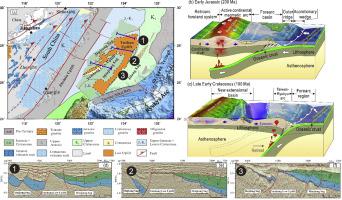当前位置:
X-MOL 学术
›
Gondwana Res.
›
论文详情
Our official English website, www.x-mol.net, welcomes your feedback! (Note: you will need to create a separate account there.)
Earth's surface responses during geodynamic evolution: Numerical insight from the southern East China Sea Continental Shelf Basin, West Pacific
Gondwana Research ( IF 6.1 ) Pub Date : 2020-12-01 , DOI: 10.1016/j.gr.2020.12.011 Ze Liu , Liming Dai , Sanzhong Li , Zhong-Hai Li , Xuesong Ding , S. Wajid Hanif Bukhari , Ian Somerville
Gondwana Research ( IF 6.1 ) Pub Date : 2020-12-01 , DOI: 10.1016/j.gr.2020.12.011 Ze Liu , Liming Dai , Sanzhong Li , Zhong-Hai Li , Xuesong Ding , S. Wajid Hanif Bukhari , Ian Somerville

|
Abstract The interaction between the Earth's surface and deep geodynamic processes has a great influence on sedimentary patterns and characteristics of sedimentary systems, especially in the continental margin, such as the southern part of the East China Sea Continental Shelf Basin (ECSCSB). However, the exact processes and dynamics are poorly understood. The numerical tool (Badlands) was adopted to simulate the geological evolution of the southern ECSCSB during the Mesozoic transitional regime of the West Pacific continental margin, between 200 and 100 Ma. The numerical model involving four-dimensional (4D) sequence stratigraphy was validated by comparing with the tectono-morphology, sedimentary environments and sediment distribution. According to our findings, the transition was mainly controlled by three structural stages. The first transitional stage of the southern ECSCSB was mainly controlled by lithospheric-scale tectonic evolution. In the second stage, the dynamic topography contributed to slow regional uplift, while the last stage showed mantle-induced dynamic subsidence. The model results on 4D geomorphic characteristics, sediment distribution of basin evolution and deep dynamic topography, provided a quantitative image for geological evolution of the West Pacific continental margin in the Mesozoic.
中文翻译:

地球动力学演化过程中的地表响应:来自西太平洋东海大陆架盆地南部的数值洞察
摘要 地表与深部地球动力学过程的相互作用对沉积格局和沉积体系特征有很大影响,特别是在大陆边缘,如东海大陆架盆地(ECSCSB)南部。然而,人们对确切的过程和动态知之甚少。采用数值工具(Badlands)模拟西太平洋大陆边缘中生代过渡期200~100 Ma期间ECSCSB南部的地质演化。通过与构造地貌、沉积环境和沉积物分布的比较,验证了涉及四维(4D)层序地层学的数值模型。根据我们的研究结果,转变主要由三个结构阶段控制。南海东部第一过渡期主要受岩石圈尺度构造演化控制。在第二阶段,动力地形促成了缓慢的区域隆升,而最后阶段则表现为地幔诱发的动力下沉。该模型的4D地貌特征、盆地演化沉积物分布和深部动力地形的模型结果,为中生代西太平洋大陆边缘的地质演化提供了定量图像。
更新日期:2020-12-01
中文翻译:

地球动力学演化过程中的地表响应:来自西太平洋东海大陆架盆地南部的数值洞察
摘要 地表与深部地球动力学过程的相互作用对沉积格局和沉积体系特征有很大影响,特别是在大陆边缘,如东海大陆架盆地(ECSCSB)南部。然而,人们对确切的过程和动态知之甚少。采用数值工具(Badlands)模拟西太平洋大陆边缘中生代过渡期200~100 Ma期间ECSCSB南部的地质演化。通过与构造地貌、沉积环境和沉积物分布的比较,验证了涉及四维(4D)层序地层学的数值模型。根据我们的研究结果,转变主要由三个结构阶段控制。南海东部第一过渡期主要受岩石圈尺度构造演化控制。在第二阶段,动力地形促成了缓慢的区域隆升,而最后阶段则表现为地幔诱发的动力下沉。该模型的4D地貌特征、盆地演化沉积物分布和深部动力地形的模型结果,为中生代西太平洋大陆边缘的地质演化提供了定量图像。

























 京公网安备 11010802027423号
京公网安备 11010802027423号